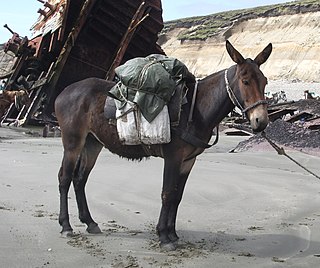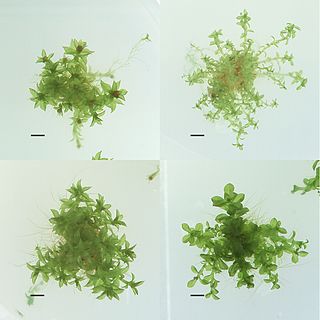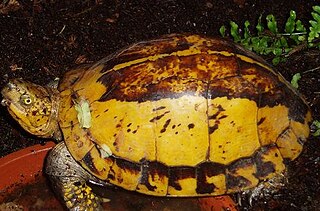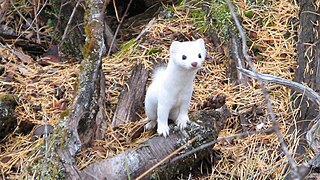Related Research Articles
Speciation is the evolutionary process by which populations evolve to become distinct species. The biologist Orator F. Cook coined the term in 1906 for cladogenesis, the splitting of lineages, as opposed to anagenesis, phyletic evolution within lineages. Charles Darwin was the first to describe the role of natural selection in speciation in his 1859 book On the Origin of Species. He also identified sexual selection as a likely mechanism, but found it problematic.

In biology, a hybrid is the offspring resulting from combining the qualities of two organisms of different varieties, species or genera through sexual reproduction. Generally, it means that each cell has genetic material from two different organisms, whereas an individual where some cells are derived from a different organism is called a chimera. Hybrids are not always intermediates between their parents, but can show hybrid vigor, sometimes growing larger or taller than either parent. The concept of a hybrid is interpreted differently in animal and plant breeding, where there is interest in the individual parentage. In genetics, attention is focused on the numbers of chromosomes. In taxonomy, a key question is how closely related the parent species are.

In biological classification, subspecies is a rank below species, used for populations that live in different areas and vary in size, shape, or other physical characteristics (morphology), but that can successfully interbreed. Not all species have subspecies, but for those that do there must be at least two. Subspecies is abbreviated subsp. or ssp. and the singular and plural forms are the same.

The greenish warbler is a widespread leaf warbler with a breeding range in northeastern Europe, and temperate to subtropical continental Asia. This warbler is strongly migratory and winters in India. It is not uncommon as a spring or early autumn vagrant in Western Europe and is annually seen in Great Britain. In Central Europe large numbers of vagrant birds are encountered in some years; some of these may stay to breed, as a handful of pairs does each year in Germany.

The mottled duck or mottled mallard is a medium-sized species of dabbling duck. It is intermediate in appearance between the female mallard and the American black duck. It is closely related to those species, and is sometimes erroneously considered a subspecies of the former.

In evolutionary ecology, an ecotype, sometimes called ecospecies, describes a genetically distinct geographic variety, population, or race within a species, which is genotypically adapted to specific environmental conditions.

In biology, a ring species is a connected series of neighbouring populations, each of which interbreeds with closely sited related populations, but for which there exist at least two "end populations" in the series, which are too distantly related to interbreed, though there is a potential gene flow between each "linked" population and the next. Such non-breeding, though genetically connected, "end populations" may co-exist in the same region (sympatry) thus closing a "ring". The German term Rassenkreis, meaning a circle of races, is also used.

In biology, two related species or populations are considered sympatric when they exist in the same geographic area and thus frequently encounter one another. An initially interbreeding population that splits into two or more distinct species sharing a common range exemplifies sympatric speciation. Such speciation may be a product of reproductive isolation – which prevents hybrid offspring from being viable or able to reproduce, thereby reducing gene flow – that results in genetic divergence. Sympatric speciation may, but need not, arise through secondary contact, which refers to speciation or divergence in allopatry followed by range expansions leading to an area of sympatry. Sympatric species or taxa in secondary contact may or may not interbreed.

In biological taxonomy, race is an informal rank in the taxonomic hierarchy for which various definitions exist. Sometimes it is used to denote a level below that of subspecies, while at other times it is used as a synonym for subspecies. It has been used as a higher rank than strain, with several strains making up one race. Races may be genetically distinct populations of individuals within the same species, or they may be defined in other ways, e.g. geographically, or physiologically. Genetic isolation between races is not complete, but genetic differences may have accumulated that are not (yet) sufficient to separate species.
In biology, a species complex is a group of closely related organisms that are so similar in appearance and other features that the boundaries between them are often unclear. The taxa in the complex may be able to hybridize readily with each other, further blurring any distinctions. Terms that are sometimes used synonymously but have more precise meanings are cryptic species for two or more species hidden under one species name, sibling species for two species that are each other's closest relative, and species flock for a group of closely related species that live in the same habitat. As informal taxonomic ranks, species group, species aggregate, macrospecies, and superspecies are also in use.

In parapatric speciation, two subpopulations of a species evolve reproductive isolation from one another while continuing to exchange genes. This mode of speciation has three distinguishing characteristics: 1) mating occurs non-randomly, 2) gene flow occurs unequally, and 3) populations exist in either continuous or discontinuous geographic ranges. This distribution pattern may be the result of unequal dispersal, incomplete geographical barriers, or divergent expressions of behavior, among other things. Parapatric speciation predicts that hybrid zones will often exist at the junction between the two populations.

The Indochinese box turtle, Vietnamese box turtle, or flowerback box turtle is a species of Asian box turtles from China, northern and central Vietnam, Laos, and possibly northeastern Cambodia. It is found in high altitude woodland where it tends to hide in the undergrowth. There is considerable confusion as to the taxonomy of this species with several subspecies being recognised by some authorities. and not by others. The International Union for Conservation of Nature has rated its conservation status as "critically endangered".

A hybrid zone exists where the ranges of two interbreeding species or diverged intraspecific lineages meet and cross-fertilize. Hybrid zones can form in situ due to the evolution of a new lineage but generally they result from secondary contact of the parental forms after a period of geographic isolation, which allowed their differentiation. Hybrid zones are useful in studying the genetics of speciation as they can provide natural examples of differentiation and (sometimes) gene flow between populations that are at some point between representing a single species and representing multiple species in reproductive isolation.

The sooty fox sparrow contains the darkest-colored taxa in the genus Passerella. It is currently classified as a "subspecies group" within the fox sparrow pending wider-spread acceptance of species status. It has long been suspected to be a separate evolutionary lineage due to morphological distinctness, and this is confirmed by analysis of mtDNA sequence and haplotype data. This group appears to be most closely related to the thick-billed and/or slate-colored fox sparrows.

The slate-colored fox sparrow group comprises the Rocky Mountain taxa in the genus Passerella. It is currently classified as a "subspecies group" within the fox sparrows pending a more-thorough genetic assay of all forms.
In biology, a cline is a measurable gradient in a single characteristic of a species across its geographical range. Clines usually have a genetic, or phenotypic character. They can show either smooth, continuous gradation in a character, or more abrupt changes in the trait from one geographic region to the next.

Caenorhabditis sinica, is a species of Caenorhabditis nematodes, belonging to the Elegans super-group and Elegans group within the genus. It is closely related to several species isolated from the lands adjacent to the Indian and Pacific Oceans, as well as to C. briggsae and C. nigoni. The species was known as “C. sp. 5” prior to 2014. C. sinica is known for having very high genetic diversity in its genome. Like other Caenorhabditis species, C. sinica is a ~1mm long roundworm with a transparent cuticle and that eats bacteria. Wild isolate strains of C. sinica have been collected from various rotting plant tissue substrates in temperate and tropical regions throughout China since its initial isolation in 2005.

The Haida ermine is a mustelid species endemic to a few islands off the Pacific Northwest of North America, namely Haida Gwaii in Canada and the southern Alexander Archipelago in the U.S. state of Alaska.

The East Siberian lemming, Eastern Siberian brown lemming, or Ognev's lemming is a species of lemming endemic to Russia, where it has a disjunct distribution throughout parts of Siberia east of the Verkhoyansk Range.

The white-headed langur is a Critically Endangered species of langur endemic to Guangxi, China.
References
- 1 2 Mayr E, Ashlock PD (1991). Principles of Systematic Zoology. Second edition. McGraw-Hill. ISBN 0-07-041144-1.